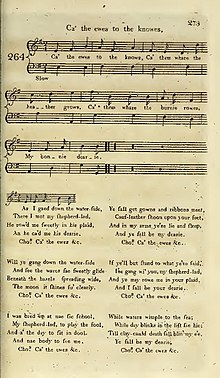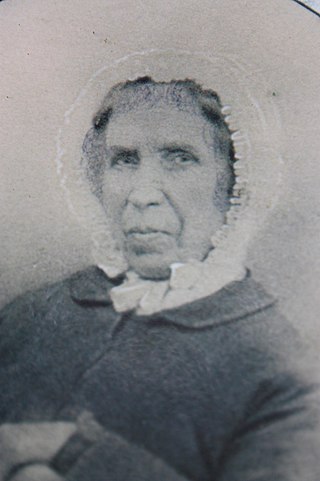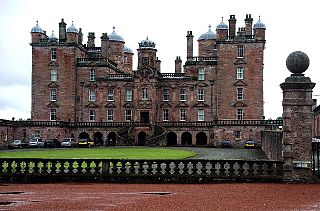
Isabel Pagan (c. 1740 – 1821), also known as "Tibbie", was a Scottish poet of the Romantic Era.

Isabel Pagan (c. 1740 – 1821), also known as "Tibbie", was a Scottish poet of the Romantic Era.

Pagan was born in 1741, about 4 miles from Nith-head in the Parish of New Cumnock, where she lived until 14 years of age. Lame from birth with a deformed foot, she also had a squint and a large tumour on her side. Unsuited for hard labour she settled in a cottage now romantically situated on the banks of the Garpel water, where she made a living by writing verses, singing and opening her cottage as a howff – a meeting place and an unofficial pub where whisky and strong drink was served in a convivial atmosphere. She was in the habit of satirizing in verse those who had offended her. She was noted for her sarcastic wit and was apparently an exceptional singer, often singing her own compositions to the delight of her rustic audience. During the shooting season her howff would be filled with aristocrats who were glad to enjoy a laugh at her humour and to hear her sing. Although never married she had a child by a man called Campbell who deserted her, on the eve of their marriage. She was unable to write; the local tailor Gemmell wrote out her verses. Known as Tibbie to her friends she died at the end of 1821 in her 80th year and was buried in the cemetery at Muirkirk. She has been titled Working class poet, as has Christian Milne.

Her best known work, "Ca' the Ewes to the Knowes" was adapted and popularised as a Scottish folk song by the poet Robert Burns. [1]
Her one published volume of poems was A Collection of Songs and Poems on Several Occasions published by Niven, Napier, and Khull in Glasgow in 1803. Some of her poetry includes:

Robert Tannahill was a Scottish poet of labouring class origin. Known as the 'Weaver Poet', he wrote poetry in English and lyrics in Scots in the wake of Robert Burns.

"Auld Lang Syne" is a popular Scottish song, particularly in the English-speaking world. Traditionally, it is sung to bid farewell to the old year at the stroke of midnight on New Year's Eve/Hogmanay. By extension, it is also often heard at funerals, graduations, and as a farewell or ending to other occasions; for instance, many branches of the Scouting movement use it to close jamborees and other functions.
"The Solitary Reaper" is a lyric poem by English Romantic poet William Wordsworth, and one of his best-known works. The poem was inspired by his and his sister Dorothy's stay at the village of Strathyre in the parish of Balquhidder in Scotland in September 1803.

Janet Hamilton was a nineteenth-century Scottish poet.

Robert Burns, also known familiarly as Rabbie Burns, was a Scottish poet and lyricist. He is widely regarded as the national poet of Scotland and is celebrated worldwide. He is the best known of the poets who have written in the Scots language, although much of his writing is in a "light Scots dialect" of English, accessible to an audience beyond Scotland. He also wrote in standard English, and in these writings his political or civil commentary is often at its bluntest.
Jean Glover or Jennifer Glover (1758–1801) was a Scottish poet and singer. She was the daughter of James Glover, handloom weaver and Jean Thomson, born in Townhead, Kilmarnock; was well educated for the time she lived in, clever and sharp-witted. She had a fine singing voice and exceedingly good looks of "both face and figure".
James Thomson was a Scottish weaver poet of Currie, near Edinburgh, whose poetry in the Scottish vernacular was published in Leith in the early 19th century. He is remembered by the Poet's Glen in Currie, a wooded dell with a scenic riverside path which is a right of way, and by a number of street names in the east of Currie.

Nelly or Nellie Kilpatrick, Helen Kilpatrick or later Nelly Bone (1759–1820). Nelly was possibly Robert Burns's first love and muse as stated by Isabella Burns.

Elizabeth "Betsey" Paton or later Elizabeth Andrew of Lairgieside was the daughter of James Paton and Eleanor Helen Paton of Aird Farm, Crossroads, Ayrshire. Following an affair with Robert Burns she gave birth on 22 May 1785 to his first child, Elizabeth "Bess" Burns, the "Dear-bought Bess", who was baptised when only two days old. Betsey met Robert Burns when she was employed as a servant girl at the Burns's Lochlea Farm during the winter of 1783–84. When the Burns family moved to Mossgiel Farm in March 1784, Betsey returned to her own home, where Robert Burns visited her later that year. In 1786, Elizabeth made a claim on Burns, but accepted a settlement of twenty pounds which the poet paid out of the profits of the Kilmarnock Edition. Loving Burns with heartfelt devotion, she continued to see him after the Burns family had moved to Mossgiel Farm, and he returned these sentiments with more physical than spiritual devotions. Isabella Begg, Burns's youngest sister, stated that although Robert did not love her, "he never treated her unkindly."
Nelly Blair, later Nelly Smith (1759–1820) is sometimes suggested as being Scottish poet Robert Burns' first love.
Isabella Steven or Tibbie Stein was the daughter of a tenant farmer from Littlehill or Little Hill Farm (NS467305) that adjoined the Burns's farm at Lochlea. 'Stein' is an alternative form of the surname 'Steven'. Littlehill had three acres of land that are said to have been little better than peat moss. She is also said to have lived in Tarbolton.
Christian Gray was a Scottish poet. Blind from a young age, Gray was known as the "blind poet" and wrote in both Scots and English. She published two volumes of poems in a variety of genres, including political, religious, and autobiographical.

Romanticism was an artistic, literary, and intellectual movement that originated in Europe toward the end of the 18th century. Scholars regard the publishing of William Wordsworth's and Samuel Coleridge's Lyrical Ballads in 1798 as probably the beginning of the movement in England, and the crowning of Queen Victoria in 1837 as its end. Romanticism arrived in other parts of the English-speaking world later; in the United States, about 1820.

Wilhelmina Alexander (1756–1843), was born at Newton House, Elderslie, Renfrewshire. She was the 4th daughter of Claud Alexander of Newton and Joanna, daughter of Alexander Cuninghame of Craigends. Her lasting fame derives from being Robert Burns's 'The Bonnie Lass o'Ballochmyle' in the song of that title. Robert Burns was accustomed to taking walks and musing over his poetry and songs in the Ballochmyle Estate next to the River Ayr when he caught sight of her one-day and composed the song in memory of the event. She refused publication at the time and Burns never forgave this perceived slight on his genius, Wilhelmina never married, she did however treasure the letter and the manuscript of the song until her dying day.
John Lapraik was a Scottish farmer and poet, and friend of Robert Burns.

"Ca' the yowes to the knowes" is a Scottish folk song collected by Robert Burns from 1794. Although sometimes attributed to Burns himself, the seven-stanza original poem is thought to be the work of Ayrshire poet Isabel Pagan, a contemporary of Burns. The poem was partially revised by Burns, and he added an eighth stanza. Burns later re-wrote the poem on a solitary stroll in the country, and this second version consists of six stanzas. It is possible that Burns was not aware that Pagan was the original author, only noting that "this song is in the true Scottish taste, yet I do not know that either air or words were ever in print before."

Tibbie Shiel (1783–1878) was a Scottish inn keeper who ran Tibbie Shiel's Inn on St Mary's Loch in the Scottish Borders and was known to many authors and poets, and the subject of numerous literary works.

Robert Burns's Commonplace Book 1783–1785 is the first of three commonplace books that were produced by the poet. The contents cover drafts of songs and poems, observations, ideas, epitaphs, etc.

'Robert Burns's Interleaved Scots Musical Museum' or the 'Interleaved Glenriddell Manuscript' is a set of four octavo volumes of James Johnson's The Scots Musical Museum in which Robert Burns provided additional material to the original publication on interleaved sheets and which he eventually gifted to Captain Robert Riddell (1755–94) of Friars Carse, Dumfries and Galloway, Scotland.

John McMurdo (1743–1803) was a friend of Robert Burns who became the chamberlain to the Duke of Queensberry at Drumlanrig Castle where the poet was a frequent visitor. His eldest daughter Jean (1777-1839) was also a close friend of Burns, who wrote the song "Bonie Jean" in her honour. As an old Nithsdale family the McMurdos were related to the Sharpes of Hoddam, the Charteris of Amisfield, the Fergussons of Craigdarroch, Dr James Currie and the Duncans of Torthorwald amongst others.